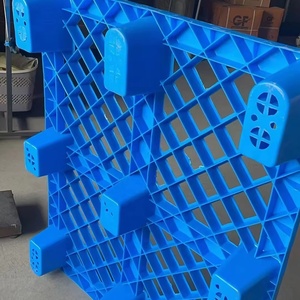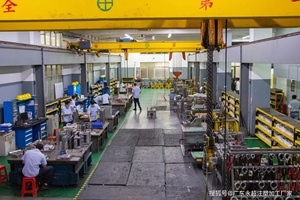
All categories
Featured selections
Trade Assurance
Buyer Central
Help Center
Get the app
Become a supplier

(1713 products available)



















The plastic pallets mold price varies depending on a number of factors. One of the factors is the type of pallet mold that is needed. Below are some of the common types available:
These are the most commonly used type of mold for manufacturing plastic pallet. They are made for high-volume production. In such industries, efficiency is vital. These molds work by injecting molten plastic into a pallet-shaped mold cavity. This technique provides a solid and consistent output, as well as decreases the cycle time of production.
These are used when making hollow plastic pallets. They tend to be lighter in weight, compared to those produced through injection molding. The process also gives high strength to the plastic through even polymer distribution.
Rotational molds are used in the production of larger plastic parts, including pallets. The process involves heating a hollow mold filled with plastic powder. As the mold rotates, it forms a uniform plastic coating over the mold's interior surface. This method is ideal for lower production volumes.
These molds are commonly used with thermosetting plastics. This process is different from injection and blow molds. A plastic material is placed in a preheated mold cavity. The mold is then closed, allowing plastic to spread and take the pallet shape. Compression molds are suitable for producing heavy-duty plastic pallets.
The plastic pallet mold plays a very important role in the oil and liquid container industries. It ensures the production of durable and lightweight pallets. Below are scenarios where these molds are critical:
For companies that are looking to produce a large number of plastic pallets, injection molds are the best. These molds also give efficiency when producing pallets, especially for oil and liquid containers. This is because they reduce the time of production by making many pallets at once.
Some industries need certain specifications for their pallets so as to accommodate unique container sizes. For those that need specific designs, rotational molds will be best. They allow the production of customized, larger, and hollow pallets. This is due to their flexibility in adjustments.
The compression molds are suitable for producing pallets needed in heavy oil drums or large liquid containers. They make sure the pallets are strong enough to carry heavy weights for long periods of time without breaking down.
Most of the time, oils and liquids are stored under varying temperature conditions. Such a situation can have a big impact on plastic mold stability. That is why injection and blow molds need to be made of highly thermal-resistant materials.
Materials used to create plastic molds for pallets include:
Thermoplastic Materials
Thermoplastic materials are among the most commonly used plastics in pallet molds. This is because they can be melted and reshaped more than once. Polypropylene (PP) is a versatile material commonly used for light to medium-duty pallets. It is resistant to many chemicals.
Another thermoplastic is polyethene (PE). This material is also widely used due to its excellent resistance to moisture and chemicals. High-density polyethylene (HDPE) is used for industrial pallets due to its strength, stiffness, and resistance to impact.
Polyvinyl Chloride (PVC)
Polyvinyl chloride is used for its durability and resistance to chemicals. Other thermoplastic materials include nylon and acrylonitrile butadiene styrene (ABS).
Thermosetting Plastics
Thermosetting plastics like melamine formaldehyde and epoxy resins are commonly used with compression molds. These materials provide enhanced strength and temperature resistance properties. EP required is very suitable for high-temperature applications.
In consideration of designing plastic pallet molds, below are some of the key specifications to keep in mind:
Pallet Design
There are two commonly used designs for plastic pallet molds. These are the 2-stringer pallet design and the 4-stringer pallet design. The 2-stringer is more lightweight and cheaper to manufacture. The 4-stringer construction offers better load-bearing capabilities.
Mold Cavity Design
The mold cavity must be well designed to reduce production defects. It is equally important for the temperature control system within the mold to be designed effectively so as to ensure even plastic material distribution. This helps in providing consistent strength across the pallet.
Mold Material
Common materials used are steel and aluminum alloys. They are used in making plastic injection molds due to their durability and resistance to wear. Aluminum molds are generally used for shorter production runs.
The quality of the produced plastic pallet molds will depend on several quality control factors. Having an understanding of them will help prevent defects. Below are some quality control factors to consider:
Material Selection
The materials chosen for making the molds directly affect the quality of plastic pallets. Poor-quality materials will lead to defects in the pallet itself. That is why only thermoplastics and thermosetting plastics that have good-quality tensile strength and temperature resistance should be used.
Mold Design
A poorly designed mold will produce pallets with uneven surfaces and even inaccurate dimensions. This will in turn lead to huge losses. Adevent quality checks should be placed during the sculpting design phase so as to sure proper functionality.
Molding Process Conditions
Temperature, pressure, and curing time should all be monitored. Any anomalies in them will lead to plastic mould defects. High-quality monitoring systems should be used so that any changes will be detected early enough.
Regular maintenance of the pallet molds ensures they operate effectively. Below are some maintenance tips:
Cleaning
The molds need to be cleaned regularly after production runs. Cleaning prevents the buildup of residue. The residue can cause the plastic to stick to the mold. This will affect the quality of the molded pallets.
Lubrication
Appropriate mold lubrication will reduce wear and tear of the plastic injection molding. This offers smoother operation. Expert lubrication will also prevent rust and corrosion of the mold.
Inspections
Inspecting the molds regularly will help identify any small damages before they become large issues. Maintenance should then be done based on the level of wear and tear.
Several economic factors impact the plastic pallet mold price. Below are the factors to consider:
Supply and Demand
The economy will affect the demand and supply of suitable materials for plastic pallet molds. High demand for these materials will lead to higher prices and the other way around. A good understanding of the relationship between supply and demand will assist in risk mitigation.
Inflation Rates
Higher inflation rates tend to increase the general cost of plastic trays. This is because inflation increases prices of such things as raw materials, labor, and transportation costs. Even though inflation is bad for manufacturers, understanding its effect will help them in adjusting their pricing strategies.
Economic Growth
Strong economic growth in a region will cause a growth in industries like oil and gas and logistics. That growth will subsequently lead to high demand for both pallets and pallet molds.
Below are such industry factors that influence the price:
Production Costs
Production costs of the molds will directly affect the price. The costs of labor and materials bear the most impact. Higher costs of skilled labor will increase the overall cost of manufacturing these molds. This in turn increases the price of the mold.
Technological Advancements
New technologies like 3D molding will help in making new plastic molds at their own prices. Older technologies will be less efficient and thus more costly to maintain. That will make their price higher.
A1: The common materials used in plastic pallet molds are steel and aluminum alloys. Manufacturers use steel because it is very durable and resistant to wear. Steel molds are good for high-volume production. Aluminum molds, on the other hand, are suitable for shorter production runs. They are lightweight and provide better thermal conductivity.
A2: Regular maintenance of these molds will ensure they operate effectively. It also increases their lifespan. Clean molds will produce high-quality pallets. Regular inspection and repair of damaged molds will prevent costly downtime.
A3: Only thermoplastics and thermosetting plastics are suitable for making pallet molds. This is because they have high-quality tensile strength and temperature resistance. Thermoplastics like polypropylene and high-density polyethylene are versatile. They are widely used due to their excellent chemical resistance and durability. As for thermosetting plastics, they commonly include melamine formaldehyde and epoxy resins. They are used for their enhanced strength and durability.
A4: Yes, they do. They come in handy during extreme temperature conditions as they protect the mold from thermal deformation. The most common temperature-resistant materials are stainless steel and high-carbon steel. They have good thermal conductivity and help in dissipating heat.
A5: The quality of the materials used and the type of maintenance done daily impacts the cost of the molds. The higher the quality of the materials, the higher the cost. Advanced maintenance will also increase the overall cost. But it will increase the lifespan of the molds and thus reduce replacement costs.